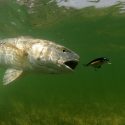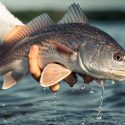Your cart is currently empty!
Tag: Red Drum
-

Ecology of the Sciaenops ocellatus (Redfish)
Note the eyespots on the redfish. Nearly every red drum will have the eyespot near the tail. Some fish may have only the single spot, others might have five or size spots.
The redfish is a member of the drum family. The color varies from copper-colored to nearly silver on the sides, with a white belly. The red drum is easily distinctive from the closely related black drum due to the fact it lacks the barbels of the latter. Redfish additionally typically have one or more eye-spots close to the base of the tail.
Range
Redfish are found from northern Mexico to Cape Cod.
Size
Redfish can grow up to 60 inches. The world record fish weighs an amazing 94 lbs. Most fish grow to a size of approximately 40 inches and 25-30lbs, though fish bigger than this aren’t all that uncommon. Most fish caught inshore weigh between 1 and 10 lbs, though bull reds are also present in inshore waters at least part of the year.
Habitat
The redfish lives in nearshore waters, and is observed everywhere from estuaries to a few miles offshore. Younger fish prefer to remain in protected areas like bays, inlets, and estuaries, whilst large fish stay mainly in open waters, even though they will spend time in covered waters to hunt. Mature adults spawn in areas with high salinity and tidal flow, such as passes and the mouth of inlets, or between barrier islands.
Redfish are frequently discovered near structure. Oyster bars, sandbars, grass beds, and reefs are all top hunting grounds for redfish, although they can additionally be located in open water over a mud bottom. They are typically discovered close to the bottom, although they will on occasion feed close to the surface. Shallow flats are another favourite hang-out of red drum, where they are frequently viewed tailing as they root out crabs, shrimp, and small fish.
Reds are a schooling fish; every school is comprised of comparable sized individuals. So if you seize a puppy drum the rest of the fish are likely of a comparable size, likewise if you seize a bull red most of the other fish are in all likelihood bulls as well. Sometimes they will school with different species as well such as black drum, speckled trout, and tarpon.
Feeding Habits
Redfish feed on a broad range of prey. Crabs, shrimp, fish and marine invertebrates make up the bulk of their diet. They typically feed on or close to the bottom, however will feed throughout the water column if the chance offers itself.
While not particularly speedy swimmers, they are capable of a rapid burst of speed that enables them to seize smaller, extra agile fish. Reds additionally like to work in schools to make bait fish “ball up.” This makes it that much less complicated to seize the prey, since the tightly packed bait in the ball has much less room to maneuver.
-

Gear and Tackle for Redfish
Redfish can be caught with a range of tackle, depending on the place you are fishing for them and what size fish you are pursuing. You can use anything from ultra-light equipment for “puppy” drum in estuaries and at river mouths to massive traditional reels for trolling baits with a heavy downrigger for huge “bull” drum.
Inshore Redfish
Redfish caught inshore are typically smaller than those caught offshore, and usually are caught in shallower water as well. Tackle can be scaled down accordingly.
An ultra-light, light, or medium-light rod is typically adequate for redfish caught inshore, the two exceptions being in the fall around passes where you will desire to scale-up your tackle to manage the bull reds; and trolling usually requires heavier gear, unless performed at very gradual speeds (more of a managed drift than trolling).
A reel with spooled with 200 yards of 10 lb test is best for inshore fishing. A proper drag is always important, as is top quality line. Inspect your line prior to fishing to make sure the line is not frayed or brittle, or you will lose fish.
Redfish rigs do not need to be complicated. The easiest setup is the freeline setup. Just tie a hook onto the line, and you are done. Nothing fancy, and it will catch a ton of fish. A variant of this setup is the leadered freeline. Instead of tying the hook straight to the mainline, you connect a leader to the line either using a swivel or an Albright or blood knot.
A word about leaders. Redfish do not have sharp teeth, and therefore may not chew you off. They do stay near structure, however, and a leader may additionally help forestall break-offs. Another cause for a leader is that many toothy fish, like bluefish and Spanish mackerel, inhabit the same waters as reds and can also bite you off. If you appear to be getting a lot of bite-offs, think about including a leader in the 20 to 25 lb range. Fluorocarbon works best, even though a well known mono leader will additionally work.
Another popular setup is the popping cork setup. A popping cork is positioned 18-36 inches above the hook. This suspends the bait up in the water column, and the sounds and vibrations from the cork attract the redfish. This is especially good at night time or in murky water and other low-visibility conditions.
The last setup we will talk about is the ‘slip-lead’ setup. In this setup, an egg sinker is connected above a swivel and a leader with a hook is tied to the different end of the swivel. The length of your lead will depend on what depth you are fishing and how quickly the current is, deeper water and quicker currents suggest larger leads. Larger leads should not be used in shallow waters as the splash might also startle fish and cause them to scatter or flee.
A 3/0 to 6/0 circle hook will work nicely for most inshore redfish.
Nearshore Redfish or Bull Reds
Redfish caught offshore, or bull reds caught in a pass at some stage in the spawn, require heavier tackle. Medium-heavy or heavy rods are ideal, with a big reel spooled with at least 250 yds of 30-lb line. Big reds can be caught on lighter tackle however this will frequently lead to the fish dying in the course of or right after the fight. Better to use heavier tackle and release the large ones alive.
The same setups used for inshore redfish can be used for bulls or offshore reds, however a large hook (5/0-8/0) ought to be used. Base your hook size on the size bait you will be using.
Trolling Tackle for Redfish
Trolling tackle for redfish should consist of at minimum, medium-light rods and a reel spooled with at least 250 yds of 20-lb test. Trolling puts a ton of stress on a rod and reel, especially if you use deep-diving type plugs.